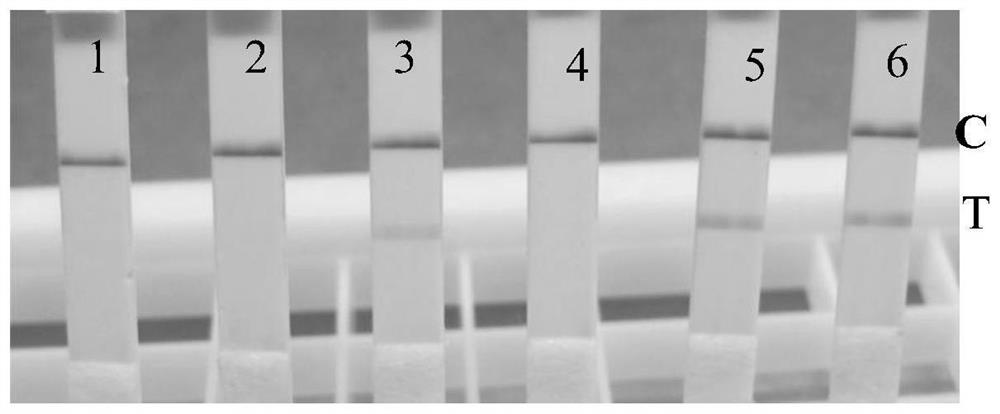Test strip RPA primer and detection kit for detecting Ditylenchus destructor
A detection kit, D. nematode technology, applied in the directions of DNA/RNA fragments, recombinant DNA technology, biochemical equipment and methods, etc., can solve the problems of difficult to meet the requirements of on-site real-time detection and high requirements for personnel quality, and achieve convenient on-site detection. , The effect of simple equipment requirements and low reaction temperature
- Summary
- Abstract
- Description
- Claims
- Application Information
AI Technical Summary
Problems solved by technology
Method used
Image
Examples
Embodiment 1
[0041] The design and screening test of test strip RPA primer and probe of embodiment 1 D. destructor potato
[0042] (1) According to the design principles of RPA primers and probes on test strips, based on the conserved region of the rDNA-ITS sequence of Ditylenchus destructor (Ditylenchus destructor), the following 5 upstream primers, 6 downstream primers and a probe were designed (both provided by Shanghai Sangon Synthetic) (see Table 1):
[0043] Table 1. LFD-RPA primer and probe sequence design list
[0044]
[0045] Among them, Biotin is to introduce a biotin group at the 5' end of the downstream primer; FAM is to introduce a fluorescein group at the 5' end of the probe; THF is tetrahydrofuran; C3-Spacer is used to introduce a spacer at the 3' end to prevent the chain extension.
[0046] (2) Extraction of D. destructor DNA:
[0047] (a) Extraction of single nematode DNA: extract according to the method of the invention patent CN109750034A.
[0048] (b) Extraction...
Embodiment 2
[0056] The specificity test of embodiment 2 test strip RPA candidate primer combination to D. destructor
[0057](1) The present inventor has disclosed a set of primers and probes for real-time fluorescent RPA for detecting D. destructor in potato in patent CN110863058A. In order to verify whether the primer-probe combination is applicable to the test strip RPA, the present invention re-base-modified according to the requirements of the test strip RPA on the basis of the sequence of the primer-probe combination (see Table 2).
[0058] Primer and probe combination after table 2 base modification
[0059]
[0060] (2) Test method:
[0061] (1) Nematodes to be tested: Ditylenchus destructor, Meloidogyne enterolobii, Meloidogyne hapla, Meloidogyne incognita, Phillips cyst nematode ( Heterodera filipjevi), Heterodera avenae, Pratylenchus zeae, Steinernemafeltiae, Heterorhabditis bacteriophora, Trichotylenchus changlingensis 1. Ditylenchus spp. in soil, all of which are stored...
Embodiment 3
[0070] The sensitivity test of embodiment 3 test strip RPA primer set of the present invention
[0071] Proceed as follows:
[0072] (1) DNA preparation: extract a single nematode genomic DNA of D. destructor in the method described in step (2) of Example 2, the total system is 10 μL, that is, the initial concentration is 0.1 head / μL, and it is carried out with a 5-fold gradient dilution method Dilution, respectively diluted to the original concentration: 1 / 5, 1 / 5 2 , 1 / 5 3 , 1 / 5 4 , 1 / 5 5 , 1 / 5 6 , 1 / 5 7 .
[0073] (2) RPA reaction system and reaction conditions: refer to steps (3) and (4) of Example 2, respectively, and 2 μL of genomic DNA of each gradient concentration was added to the template.
[0074] Results (see Figure 6 ) at 1 / 5, 1 / 5 2 , 1 / 5 3 , 1 / 5 4 Under the dilution multiples of the T line, there are obvious red bands, indicating that the detection limit of the detection method of the present invention is 0.1 head / μL×1 / 5 4 ×2μL=1 / 5 5 The DNA of 1 / 312...
PUM
 Login to View More
Login to View More Abstract
Description
Claims
Application Information
 Login to View More
Login to View More - R&D
- Intellectual Property
- Life Sciences
- Materials
- Tech Scout
- Unparalleled Data Quality
- Higher Quality Content
- 60% Fewer Hallucinations
Browse by: Latest US Patents, China's latest patents, Technical Efficacy Thesaurus, Application Domain, Technology Topic, Popular Technical Reports.
© 2025 PatSnap. All rights reserved.Legal|Privacy policy|Modern Slavery Act Transparency Statement|Sitemap|About US| Contact US: help@patsnap.com



